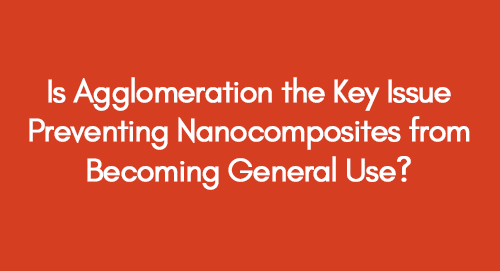
Israeli Objectives for Invading Lebanon in 1982
June 16, 2022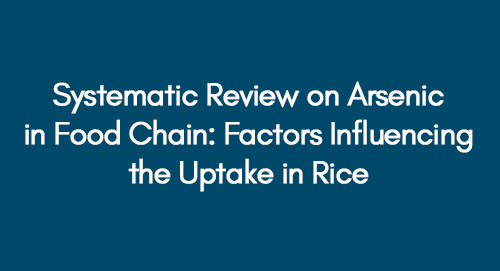
Systematic Review on Arsenic in Food Chain: Factors Influencing the Uptake in Rice
June 16, 2022Agglomeration emerges as the critical hurdle inhibiting the ubiquitous adoption of nanocomposites, introducing a nuanced complexity that hinders their seamless integration into everyday applications.
Nanocomposites have sparked immense enthusiasm within the materials science community due to their potential to drive innovation in various industries, including aerospace, automotive, and electronics. These materials represent a cutting-edge class of composites wherein nanoscale particles are dispersed throughout a bulk matrix. Their allure lies in the promise of delivering exceptional mechanical, electrical, and thermal properties, making them incredibly appealing for a wide spectrum of applications. By merging the remarkable characteristics of nanoscale materials with the versatility of conventional bulk matrices, nanocomposites open the door to unprecedented possibilities for material science.
Explore More About Nanocomposites
However, amid this excitement and optimism, a formidable challenge looms large, impeding the widespread adoption of nanocomposites: agglomeration. Agglomeration is a phenomenon where the nanoscale particles exhibit a tendency to clump together within the composite material rather than remaining uniformly dispersed. This issue carries significant consequences, potentially undermining the intended benefits of nanocomposites by diminishing mechanical strength, introducing property inconsistencies, and limiting their real-world performance. To harness the full potential of nanocomposites and enable their seamless integration into diverse industries, overcoming the challenge of agglomeration has become a pressing priority. In this blog, we will delve deeper into what agglomeration entails, why it represents a critical obstacle for nanocomposites, and explore the ongoing efforts to surmount this formidable hurdle.
Introduction
The article explores the role of agglomeration in the conductivity of carbon nanotube composites near percolation. Agglomeration, akin to conductivity, is studied at low concentrations in these composites. As concentration rises, agglomeration spots increase uniformly but with consistent agglomerate size, influenced by the initial carbon nanotube proportion. Agglomeration can create voids, favouring bundled nanotubes. It affects charge conduction, with simulations showing its impact. Agglomeration hinders charge conduction but benefits optimal conduction at low concentrations. As concentration increases, conductivity becomes less agglomeration-dependent due to established percolation pathways.

Figure 1 Pathway of Percolation
Prior research has regarded carbon nanotubes as versatile additives for modifying the physical properties of materials like polymers and tiles, rendering them suitable for various applications. Carbon nanotubes essentially consist of hexagonally arranged carbon atoms akin to graphene sheets. Experimental studies have underscored the critical importance of effectively dispersing carbon nanotubes within composite materials to showcase their unique properties.
Carbon nanotubes possess a considerable size, yet they are internally hollow, rendering them lightweight. This characteristic renders carbon nanotubes highly suitable as nanofillers for enhancing the physical properties of materials. They bolster strength thermal and electrical conductivity, all while reducing overall weight. Carbon nanotubes find application in altering the electrical properties of composite materials, serving functions such as shielding against electromagnetic interference, reducing electrostatic effects, and enabling strain sensing for health monitoring.
In the context of percolation, a uniform distribution of carbon nanotubes offers an enhanced conductivity pathway with reduced mobility. The article addresses key factors surrounding the role of agglomeration in shaping the conductivity of carbon nanotube composites in proximity to percolation.
The article has played a crucial role in simplifying the complexities of carbon nanotube composites for the broader public, shedding light on why these materials have not yet reached widespread use. It has also paved the path for future research to address and resolve this issue, offering new directions for exploration.
Reflective Commentary
The paper selection process prioritized papers authored by experts, ensuring the research's factual and valuable content. Recent papers were chosen to provide up-to-date knowledge, focusing on addressing the persistent issue of nano-filler agglomeration during dispersion. The selected papers, authored by different experts and featuring multiple contributors, covered various topics and issues. These papers contributed unique insights, and their contents were meticulously integrated to inform a comprehensive analysis for future research.
The chosen papers contributed substantial value to the research due to their unique content. Each paper's distinct aspects were carefully examined and incorporated into the study. These ten selected papers covered various research topics, some focusing on agglomeration and others on nanoparticles. The selection was based on the value they could bring to the research, with one paper, for instance, presenting diverse causes of agglomeration and proposing effective solutions. The researcher plans to amalgamate the information and knowledge from these papers, resulting in a comprehensive analysis within the final research.
Literature Review
The literature review typically includes a summary and analysis of relevant research articles, books, and other scholarly sources. It can also reveal trends, debates, and areas where further research is needed. In essence, a well-executed literature review is the backbone of any research project, guiding the research questions and methodology while demonstrating the researcher's familiarity with the subject matter.
Introduction
In their study, Atif and Inam emphasized that incorporating nano-fillers into polymers can lead to remarkable enhancements in polymer performance. Nano-fillers exhibit distinctive chemical properties characterized by a significant surface-to-volume ratio and a rich surface chemistry. These materials possess elevated surface energies owing to their substantial surface area. When high-energy nano-fillers are introduced into polymers, they foster robust interfacial interactions.
However, the practical application of polymer nanocomposites faces a series of challenges related to filler dispersion. Notably, van der Waals forces play a significant role, contributing to the agglomeration of materials like MLG (multi-layer graphene) and CNTs (carbon nanotubes), as detailed in the research conducted by Atif and Inam in 2006.
Further insights into carbon nanotubes (CNTs were provided by Tarlton et al. According to their findings, CNTs serve as filler materials capable of modifying the physical properties of various polymers. It has become apparent that CNTs tend to aggregate or agglomerate in conjunction with graphene and other composite materials. Building upon Atif and Inam's 2016 publication and Tarlton et al.'s 2017 study, it has been elucidated that, during the production of polymer nanocomposites, carbon nanotubes congregate into bundles due to the influence of Van Der Waals interactions.
As a result, this review will centre on the issue of agglomeration and explore whether it constitutes a pivotal obstacle to the widespread utilization of nanocomposites.
Theoretical Framework
In the study conducted by Rishi et al. in 2019, it was observed that the size of agglomerates decreased, and this phenomenon was elucidated through the onion peel theory. Scanning Electron Microscopy (SEM) images vividly illustrated that agglomerates peeled away from their surfaces, resembling the layers of an onion being removed.
However, Coran and Donnet proposed a model highlighting disparities in the dispersion rate over time. This model revealed that the number of undispersed fillers corresponded to the count of agglomerates with sizes exceeding five micrometres, a finding supported by Rishi et al. in their 2019 study.
Numerous models exist in the literature to assess the strength of agglomerates. For instance, in Deng et al.'s 2016 publication, the Weiler model assigned significant importance to the overall size of elements, considering the total scattering of primary elements. In contrast, the power dependence of the theory, as compared to the Kendall theory, was relatively minor due to the influence of defects within the agglomerates, as depicted in Figure 1.
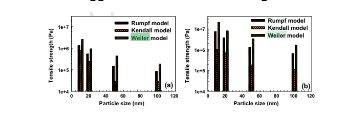
Figure 2 Size of nanoparticles (adapted from Deng et al. 2016)
This model effectively measures agglomerate strength by observing broken contacts within agglomerates. Weiler et al. 2010 emphasized that forces on the agglomerate's surface have fewer contact partners than inner regions. Zare's 2016 research focused on reinforcing nanocomposites through nanoparticle agglomeration rather than nanoparticle-polymer bonding. Additionally, Zare's 2015 study explored the Kelly-Tyson theory, highlighting the higher maximum stress in carbon nanotubes compared to their failure stress, resulting in their breakage. These insights are crucial in addressing agglomeration challenges and optimizing nanocomposite properties.
Defining Nanocomposites and Agglomeration
Nanocomposites are materials characterized by two phases, with one having dimensions less than a hundred nanometers. These nanocomposites exhibit various advantageous properties, including enhanced bulk strength, heightened thermal stability, and reduced permeability, achieved with a low nanofiller concentration. Zare's 2016 research underscores the numerous advantages of nanocomposites, highlighting their accessibility, ease of fabrication, and possession of high-level optical, electrochemical, and magnetic properties, all at a relatively low cost.
However, agglomeration challenges nanocomposites, impacting their structural and mechanical properties. Zare's study also emphasizes the role of nanofiller size in mitigating nanoparticle agglomeration. Larger nanoparticles in nanocomposites tend to reduce agglomeration while introducing more nanofiller material can increase agglomeration.
In summary, nanocomposites offer a wealth of desirable characteristics, but managing agglomeration is crucial to maintaining and enhancing their properties. This issue is influenced by both nanofiller size and the volume of nanofillers in polymer nanocomposites, and understanding these dynamics is essential for optimizing nanocomposite performance.
Agglomerations are clusters of nanoparticles and represent the solid components within collections. In nanocomposite production, smaller agglomerates tend to have a more significant agglomeration effect. Loosely aggregated materials influence agglomeration and can be disrupted by mechanical forces.
Zare's 2016 publication highlights that agglomeration negatively impacts the properties and quality of nanoparticles, including factors like stress force and distribution. This phenomenon is driven by mutual forces between nanoparticles, often called Van der Waals forces. Managing agglomeration is crucial for optimizing nanocomposite performance.
Properties of Nanoparticle Agglomerates
Agglomerates impact nanoparticle properties, including electrical conductivity. Deng et al.'s 2016 research showed interesting electrical characteristics in nanoparticle agglomerates. Hydrodynamic area governs their transport properties.
Nanoparticles' unique electrical, photo-electronic, and optical attributes make them valuable for research, as highlighted by Yang et al. in 2012. The interphase, an adjacent region in the polymer matrix with distinct properties, is crucial.
Additionally, Odegard, Clancy, and Gates' 2005 model analyzed the elasticity of composites featuring nanoparticles with similar spherical boundaries. The interphase, near the spherical surface, is a key factor.
In summary, agglomerates impact nanoparticle properties, particularly electrical conductivity, and the interphase is crucial in composite material behaviour.
Zare's 2016 research acknowledged the challenges in assessing the structural and mechanical properties of agglomerates, such as permeability, order, and strength. High-resolution imaging devices were often unavailable, and experimental techniques were limited. Permeability, which signifies the ratio of vacuum volume to the volume occupied by densely packed particles, provided insights into the packing properties of nanoparticles. These nanoparticles were evaluated based on their effective parameters and performance, particularly in thermal and mechanical properties.
Agglomeration is a Key Issue Preventing Nanocomposites from becoming General Use.
Nanoparticles should be combined with specific materials to minimize agglomeration. Xuyan et al.'s 2018 research suggests incorporating conductive materials like carbon nanotubes into nanosheets to prevent agglomeration and enhance conductivity. Three-dimensional nanocomposites are less prone to agglomeration, maintaining an active surface area over time.
Tarlton et al.'s 2017 study highlights the detrimental effects of agglomeration on nanocomposite thickening. On the other hand, Atif and Inam's 2016 publication recommends methods to avoid agglomeration, including organic solvents, precise diffusion techniques, and functionalized fillers.
In summary, strategic integration of nanoparticles with specific materials and careful techniques can mitigate agglomeration in nanocomposites, optimizing their performance.
Other Factors Affecting Nanocomposites From Becoming General Use
In the research done by Atif and Inam (2016), one of the reasons that prevent the production of enhanced polymer nanocomposites is that high-performing polymers are only achieved if the dispersion of the filler is uniform; otherwise, agglomeration will occur. The dispersion state of fillers plays a major role in preventing the production of polymer nanocomposites because the Van der Waals forces are in factor and cause agglomeration between MLG and CNTs. Additionally, the high thermal conductivity of carbon nanotubes and multilayer graphene produced conductive (electrical and thermal) polymer nanocomposites. In the publication by Atif and Inam (2016), past studies identified that nanocomposites of carbon nanotubes and multilayer graphene can be used as a support for the growth of cells and transplant resources for flawed bones of humans. The issue needed a solution before including carbon nanotubes and multi-layer graphene polymer nanocomposite in human beings. The main factor on which the polymer nanocomposite properties depended is the bond strength (interfacial). Nanocomposites are manufactured at low temperatures to increase the configuration of carbon nanotubes. Nanocomposites were found to have damping capacity at a higher range of temperatures, as described in the study by Atif and Inam (2016). In the research done by Atif and Inam (2016), multi-layer Graphene has the capability of improving the flexural and mechanical properties of nanocomposites.
MLG has a coiled structure and tends to undergo wrinkling when compressed (in-plane) or shear. Wrinkling changes the shape of thin and flexible material, as stated in the study of Atif and Inam (2016) and shown in Figure 2.
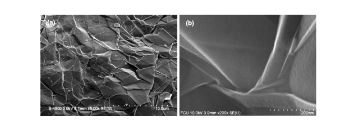
Figure 3 Wringkling of multi-layer Graphene: a) typical wrinkling pattern b) magnified view of wrinkles (adapted from Atif and Inam 2016)
In the publication by Xuyan et al. (2018), when wrinkling occurs in MLG, MLG’s shape is not allowed to be regained as the strain energy stored within MLG is insufficient. If sufficient elastic strain energy is not stored within MLG, irreversible wrinkling occurs, which can only be altered through external effects.
Nanoparticle Aggregation/Agglomeration in Polymer Particulate Nanocomposites
In the research done by Zare (2016), it has been established that the aggregation/agglomeration of nanoparticles occurs in every nanocomposite. When nanoparticles are in the process of production or are being incorporated into the polymer, aggregation/agglomeration is formed. It has been recognised that Van der Waals forces or chemical bonds play a factor in direct mutual attraction between nanoparticles by causing aggregation/agglomeration. Aggregation/agglomeration can be avoided by particle coating using capping agents, separating them by charging the filler surface using electrostatic revulsions, and applying a coupling agent or compatibiliser. Additionally, if optimal parameters are used in the production process, aggregates can be broken effectively. It has been stated in the research done by Zare (2016) and *Zare (2017) that the aggregation/agglomeration level in nanocomposites can be increased by reducing the filler size and adding non-filler content. A high concentration of nanofillers in polymer nanocomposites is harmful because the agglomerates produce several defects in the samples that are responsible for worsening the properties of polymer nanocomposites. When the nanoparticles are concentrated efficiently in polymer nanocomposites, the size of polymer nanocomposites is reduced through the agglomeration of nanoparticles.
Reasons and Remedies for the Agglomeration
In the research done by *Calisi et al. (2013), Agglomeration can be prevented and controlled by tailoring the dispersion state of nano-fillers. Certain processes can tailor the state of nano-fillers and thus avoid the factor of agglomeration in nanocomposites, as described by Atif and Inam (2016) and *Calisi et al. (2013).
Organic Solvents
In the research done by *Fujisawa et al. (2013), the dispersion state of fillers is improved using dispersant solvents. The dispersion state of fillers is improved by lowering the viscosity of the polymer matrix. The dispersant solvent eases the dispersion process because of its vital characteristics. It exists in the low viscous state and thus can lower the viscosity of the polymer matrix, which eventually helps in the dispersion process as described by Atif and Inam (2016) and *Fujisawa et al. (2013). Few cases reported that using organic solvents in polymers has affected their mechanical properties. However, the mechanical properties were not affected by the usage of organic solvents having a low boiling point. In the publication by Atif and Inam (2016), it was stated that organic solvents have advantages and disadvantages regarding the properties of polymers.
Methods for Dispersion
Agglomeration can be prevented with different methods of dispersion. In the research done by *Calisi et al. (2013), it is stated that different approaches can be used to disperse nano-fillers in the polymer. The external force can be applied to nano-fillers to disentangle them, after which the disentangled dispersed nano-fillers can be enclosed in the polymer matrix as described by *Calisi et al. (2013). The enclosing is done to prevent the nano-fillers from re-aggregating and to yield metastable dispersion. The forces applied to the nano-fillers can be mechanical stirring or sonication. The other approach most persistently used is the disentangling of nano-fillers by dispersing them in a suitable solvent. However, graphene sheets are first separated and then dissolved for graphene-based nano-fillers, eventually resulting in polymer solutions as described by Atif and Inam (2016) and *Calisi et al. (2013).
In the research done by *Calisi et al. (2013) and Atif and Inam (2016), in the sonication process, high-frequency sound waves are used in agitating the nano-fillers in a solution. A Sonication device, as shown in Figure 3, is used for sonication processes that are of high energy and uniformly disperse the MLG and CNTs in the polymer matrix.
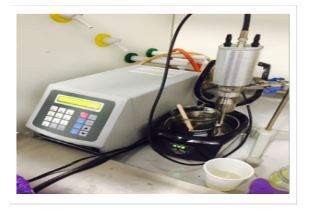
Figure 4 Sonication device (adapted from Atif and Inam 2016)
Calendering is another method which uses shear force to disperse nano-fillers in the polymer, as shown in Figure 4.

Figure 5 A) Calendering mill and B) its working principle (adapted from Atif and Inam 2016)
A calendaring mill is a specially designed three-roll mill with gaps between its rolls. During calendaring, the roll gaps in the calendar produce a great force that disperses, mixes and homogenises viscous materials. Ball Milling is also used for the dispersion of MLG and CNT; high-quality ball mills are used to reduce the size of particles.
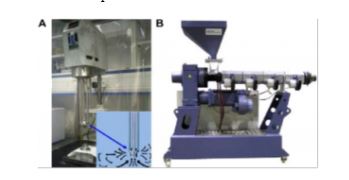
Figure 6 A) shear mixer and B) extruder (adapted from Atif and Inam 2016)
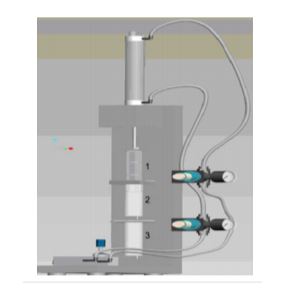
Figure 7 Schematic of the shearing device (adapted from Atif and Inam 2016)
High-shear mixing and extrusion is another common method with which high numbers of CNTs are dispersed uniformly; twin screws rotating at high speed create a shear flow to disperse CNT agglomerates, as shown in Figure 6.
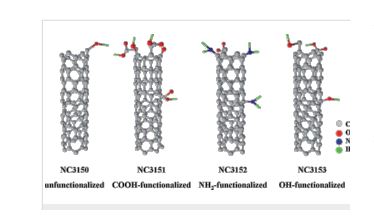
Functionalisation
In the research done by *Gu et al. (2016), functionalisation is another process that solves dispersion-related problems by modifying the surface of particles. Further added by Atif and Inam, the surface of graphene needs modification to disperse in the polymer matrix; alpine has a very smooth surface, which creates weak interfacial bonds with polymer because of the properties of polymer nanocomposites, the properties depend heavily on the strength of its interfacial bonds. Different functionalisation methods help disperse MLG and CNTs in the polymer matrix. Furthermore, the oxidation method is used for modifying the surface of CNTs; different treatments are used for successfully performing the oxidation method. Superacids are another method with which modification of MLG and CNTs can be achieved; strong acids can be used in dissolving and dispersing MLG and CNTs in large numbers, as described by Atif and Inam (2016) and *Gu et al. (2016). The use of nitric acid and sulphuric acid as remedies resulted in the functionalisation of carbon nanotubes and multi-layer graphene and also reduced the size of fillers.

Figure 8 Functionalisation process (adapted from Atif and Inam 2016)
The functionalisation reduced the clipping force of nanotubes to 15 per cent, and the mechanical properties of nanocomposites were affected.
Hybrid Nano-Fillers
In the research done by Atif and Inam (2016), it was observed that the state of dispersion of MLG and CNTs in the polymer matrix is also improved by adding hybrid nano-fillers. Hybrid fillers used as synergistic effects caused an enhancement in the dispersion state of fillers. Further added by Atif and Inam (2016), the physical properties of hybrid nanocomposites are improved when hybrid nano-fillers create synergistic effects. Physical synergistic effects occur during dispersion because of the multiphase hybrid structure of Titania. Moreover, further synergistic effects are found during dispersion when nano clay is used, as described by Atif and Inam (2016). Therefore, the enhancement in the state of dispersion is dependent upon synergistic effects among the nanofillers such as carbon nanotubes and Titania.
Chapter Summary
This review revolves around the theoretical framework, the concept of nanoparticles and agglomeration and the properties of nanoparticle agglomerates. Part of the review discusses agglomeration as a key issue preventing nanocomposites from becoming of general use. Furthermore, this review discusses the factors affecting nanocomposites from becoming general use, Nanoparticle aggregation/agglomeration in polymer particulate nanocomposites and Reasons and remedies for the agglomeration. The theoretical framework comprises different models explaining the concept of nanoparticles, nanocomposites and agglomerates. The concept of nanoparticles was described with properties which included the mechanical, thermal and electrical properties of nanoparticles agglomerates. Reasons and remedies for the agglomeration describe the nature of organic solvents, methods of dispersion for carbon nanotubes and multi-layer graphene, the functionalisation process for carbon nanotubes and multi-layer Graphene and the concept of Hybrid nanofillers.
Conclusion
Nanocomposites are double-phased dense materials; they have extensive characteristics and exhibit significant revenues. However, the production of nanocomposites is not practical because agglomeration occurs between nano-fillers during dispersion; furthermore, the nonproduction of nanocomposites is because of the structure of nano-fillers. Nanocomposites are produced when nano-fillers, MLG and CNTs are dispersed; however, during dispersion, MLG and CNTs were agglomerating because the physical properties of carbon nanotubes (CNTs) were altering the polymer matrix and agglomerating with MLG. However, dispersing nano-fillers in large quantities has decreased the chances of agglomeration to some extent.
Agglomerates influence the properties of nano-fillers. Nano-fillers are good conductors of electricity, and thus, they agglomerate due to electromagnetic responses. Furthermore, the interphase properties of the neighbouring region of the polymer have different mechanical and chemical properties. The optical, electrical and photo-electronic properties of nano-fillers were not adjusting with the interphase properties.
The agglomeration can be controlled and prevented through various methods, including changing the dispersion state of nano-fillers. Organic solvents can be used to improve the dispersion state of fillers; these solvents can lower the viscosity of the polymer matrix, and thus the dispersion process can be eased. Other methods include applying force to disentangle nano-fillers and then enclosing them in the polymer matrix and modifying the nanofiller's surface to make the dispersion process feasible. Furthermore, adding hybrid nano-fillers forms hybrid nanocomposites; these nanocomposites are created when hybrid nano-fillers are combined with nano-fillers, such as MLG and CNTs. Synergistic effects occur during dispersion when nano-fillers are combined with hybrid nano-fillers.
Significant progress has been made over the years in solving nano-filler agglomeration; however, further research is due to make the production of nanocomposites practical. Further insights will be given on solving agglomeration when nanocomposite production starts, and significant changes will occur towards the further advancement of similar technologies.
References
K. Rishi, V. Narayanan, G. Beaucage, A. McGlasson, V. Kuppa, J. Ilavsky and M. Rackaitis, A thermal model to describe kinetic dispersion in rubber nanocomposites: The effect of mixing time on dispersion, Polymer, 2019, 175, 272–282.
R. Atif and F. Inam, Reasons and remedies for the agglomeration of multilayered graphene and carbon nanotubes in polymers, Beilstein J. Nanotechnol., 2016, 7, 1174–1196.
Tarlton, E. Sullivan, J. Brown and P. A. Derosa, The role of agglomeration in the conductivity of carbon nanotube composites near percolation, Journal of Applied Physics, 2017, 121, 085103.
X. Deng, Z. Huang, W. Wang and R. N. Davé, Investigation of nanoparticle agglomerates properties using Monte Carlo simulations, Advanced Powder Technology, 2016, 27, 1971–1979.
X. Liu, J. Zeng, H. Yang, K. Zhou and D. Pan, V 2 O 5 -Based nanomaterials: synthesis and their applications, RSC Adv., 2018, 8, 4014–4031.
Y. Zare, Study of nanoparticles aggregation/agglomeration in polymer particulate nanocomposites by mechanical properties, Composites Part A: Applied Science and Manufacturing, 2016, 84, 158–164.
N. Calisi, A. Giuliani, M. Alderighi, J. M. Schnorr, T. M. Swager, F. Di Francesco and A. Pucci, Factors affecting the dispersion of MWCNTs in electrically conducting SEBS nanocomposites, European Polymer Journal, 2013, 49, 1471–1478. Liu, F., Hu, N., Ning,
F. Liu, N. Hu, H. Ning, Y. Liu, Y. Li and L. Wu, Molecular dynamics simulation on interfacial mechanical properties of polymer nanocomposites with wrinkled graphene, Computational Materials Science, 2015, 108, 160–167.
S. Fujisawa, T. Saito, S. Kimura, T. Iwata and A. Isogai, Surface Engineering of Ultrafine Cellulose Nanofibrils toward Polymer Nanocomposite Materials, Biomacromolecules, 2013, 14, 1541–1546.
J. Gu, X. Yang, Z. Lv, N. Li, C. Liang and Q. Zhang, Functionalized graphite nanoplatelets/epoxy resin nanocomposites with high thermal conductivity, International Journal of Heat and Mass Transfer, 2016, 92, 15–22.
Y. Zare, K. Y. Rhee and D. Hui, Influences of nanoparticles aggregation/agglomeration on the interfacial/interphase and tensile properties of nanocomposites, Composites Part B: Engineering, 2017, 122, 41–46.
Get 3+ Free Dissertation Topics within 24 hours?

















